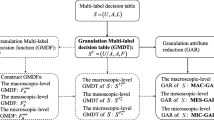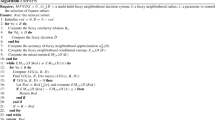Abstract
In this paper, on the basis of the rough set theory, four attribute reduction algorithms are proposed for multi-label data. In order to improve the computational efficiency, the proposed algorithms utilize the lower approximations of the label information set instead of the decision class to evaluate the importance of attributes. The relationship between the proposed methods and two classical attribute reductions is analyzed and shows that the proposed methods are more applicable to multi-label classification. Experimental results reveal that the proposed algorithms can remove redundant attributes without reducing classification accuracy for most data.
Similar content being viewed by others
References
Boutell MR, Luo J, Shen X, Brown CM (2004) Learning multi-label scene classification. Pattern Recognit 37(9):1757–1771
Chen YM, Miao DQ, Wang RZ (2010) A rough set approach to feature selection based on ant colony optimization. Pattern Recognit Lett 31(3):226–233
Hu QH, Yu DR, Liu JF, Wu C (2008a) Neighborhood rough set based heterogeneous feature subset selection. Inf Sci 178(18):3577–3594
Hu QH, Yu D, Liu JF, Wu C (2008b) Neighborhood-rough-set based heterogeneous feature subset selection. Inf Sci 178(18):3577–3594
Hu QH, Yu DR, Xie ZX (2008c) Neighborhood classifiers. Expert Syst Appl 34(2):866–876
Jia XY, Liao WH, Tang ZM, Shang L (2013) Minimum cost attribute reduction in decision-theoretic rough set model. Inf Sci 219:151–167
Li H, Li D, Zhai Y, Wang S, Zhang J (2016) A novel attribute reduction approach for multi-label data based on rough set theory. Inf Sci 367–368:827–847
Lin Y, Hua Q, Liu J, Chen J, Duan J (2016) Multi-label feature selection based on neighborhood mutual information. Appl Soft Comput 38:244–256
Lin Y, Li Y, Wang C, Chen J (2018) Attribute reduction for multi-label learning with fuzzy rough set. Knowl Based Syst 152:51–61
Liu J, Lin Y, Li Y, Weng W, Wu S (2018) Online multi-label streaming feature selection based on neighborhood rough set. Pattern Recognit 84:273–287
Pawlak Z (1982) Rough sets. Int J Comput Inf Sci 11:34l–356
Pawlak Z (1991) Rough sets: theoretical aspects of reasoning about data. Kluwer Academic Publishers, Boston
Pedrycz W, Al-Hmouz R, Balamash AS, Morfeq A (2015) Hierarchical granular clustering: an emergence of information granules of higher type and higher order. IEEE Trans Fuzzy Syst 23(6):2270–2283
Schapire RE, Singer Y (2000) Boostexter: a boosting-based system for text categorization. Mach Learn 39(2–3):135–168
Slezak D (2015) On generalized decision functions: reducts, networks and ensembles. In: Yao Y, Hu Q, Yu H, Grzymala-Busse JW (eds) Rough sets, fuzzy sets, data mining, and granular computing: proceedings of the 15th international conference, RSFDGrC 2015, Tianjin, China. Lecture notes in computer science, vol 9437. Springer, Basel, pp 13–23
Tsoumakas G, Katakis I, vlahavas IP (2011) Random klabelsets for multilabel classification. IEEE Trans Knowl Data Eng 23(7):1079–1089
Vluymans S, Cornelis C, Herrerra F, Saeys Y (2018) Multi-label classification using a fuzzy rough neighborhood consensus. Inf Sci 96(114):433–434
Wang C, Qian Y, Hu Q, Chen D, Lin Y (2016) A fitting model for feature selection with fuzzy rough sets. IEEE Trans Fuzzy Syst 25(4):741–753
Yu Y, Pedrycz W, Miao D (2013) Neighborhood rough sets based multi-label classification for automatic image annotation. Int J Approx Reason 54:1373–1387
Zhang ML, Zhou ZH (2006) Multilabel neural networks with applications to functional genomics and text categorization. IEEE Trans Knowl Data Eng 18(10):1338–1351
Zhang M, Zhou Z (2007) ML-KNN: a lazy learning approach to multi-label learning. Pattern Recognit 40:2038–2048
Zhang ML, Zhou ZH (2014) A review on multi-label learning algorithms. IEEE Trans Knowl Data Eng 26(8):1819–1837
Zhao SY, Tsang CC, Chen D (2010) Building a rule-based classifier by using fuzzy rough set technique. IEEE Trans Knowl Data Eng 22(5):624–638
Zhao H, Wang P, Hu QH (2016) Cost-sensitive feature selection based on adaptive neighborhood granularity with multi-level confidence. Inf Sci 366:134–149
Acknowledgements
This work has partially been supported by China Scholarship Council (No. 201808210064), the National Natural Science Foundation of China (Nos. 61572082 and 11971475), Natural Science Foundation of Liaoning Province of China (No. 20170540004 and No. 20170540012), Educational Commission of Liaoning Province of China (No. LZ2016003), the overseas research program of CUMT (No. G20190010048), and the 2019 - 2020 Hunan overseas distinguished professorship project (No. 2019014). The author Qiao also thanks the UT President’s Endowed Professorship (Project # 450000123) for its partial support.
Author information
Authors and Affiliations
Corresponding author
Ethics declarations
Conflict of interest
The authors declare that they have no conflict of interest.
Ethical approval
This article does not contain any studies with human participants or animals performed by any of the authors.
Additional information
Communicated by V. Loia.
Publisher's Note
Springer Nature remains neutral with regard to jurisdictional claims in published maps and institutional affiliations.
Rights and permissions
About this article
Cite this article
Fan, X., Chen, Q., Qiao, Z. et al. Attribute reduction for multi-label classification based on labels of positive region. Soft Comput 24, 14039–14049 (2020). https://doi.org/10.1007/s00500-020-04780-4
Published:
Issue Date:
DOI: https://doi.org/10.1007/s00500-020-04780-4




